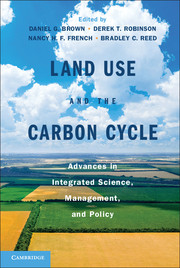Book contents
- Frontmatter
- Contents
- Chapter Authors and Affiliations
- Acknowledgments
- Acronyms
- Part I Introduction
- Part II Measurement and Modeling
- Part III Integrated Science and Research Applications
- 9 Carbon Emissions from Land-Use Change: Model Estimates Using Three Different Data Sets
- 10 A System to Integrate Multiscaled Data Sources for Improving Terrestrial Carbon Balance Estimates
- 11 Simulated Biogeochemical Impacts of Historical Land-Use Changes in the U.S. Great Plains from 1870 to 2003
- 12 Carbon Signatures of Development Patterns along a Gradient of Urbanization
- Part IV Land Policy, Management, and the Carbon Cycle
- Part V Synthesis and Future Directions
- Index
- Plate Section
- References
12 - Carbon Signatures of Development Patterns along a Gradient of Urbanization
Published online by Cambridge University Press: 05 February 2013
- Frontmatter
- Contents
- Chapter Authors and Affiliations
- Acknowledgments
- Acronyms
- Part I Introduction
- Part II Measurement and Modeling
- Part III Integrated Science and Research Applications
- 9 Carbon Emissions from Land-Use Change: Model Estimates Using Three Different Data Sets
- 10 A System to Integrate Multiscaled Data Sources for Improving Terrestrial Carbon Balance Estimates
- 11 Simulated Biogeochemical Impacts of Historical Land-Use Changes in the U.S. Great Plains from 1870 to 2003
- 12 Carbon Signatures of Development Patterns along a Gradient of Urbanization
- Part IV Land Policy, Management, and the Carbon Cycle
- Part V Synthesis and Future Directions
- Index
- Plate Section
- References
Summary
Introduction
The Earth's urban population has increased dramatically over the past century, from 224 million in 1900 to 2.9 billion in 2000 (United Nations [UN] 2004). Currently, more than 50 percent of the world's population lives in urban areas (3.5 billion), and it is expected that this proportion will reach nearly 70 percent (6.3 billion) in 2050 (UN 2009). Although urbanized areas cover only approximately 1 to 6 percent of Earth's surface, they are major determinants of environmental change well beyond their city boundaries (Alberti et al. 2003; Grimm et al. 2008; Schneider, Friedl, and Potere 2009). Urbanization affects the Earth's ecosystems by changing the landscape, altering biophysical processes and habitat, and modifying major biogeochemical cycles (Grimm et al. 2000, Picket et al. 2001, Alberti et al. 2003, Foley et al. 2005). The expanding urban population will place increasing demand on both the productive and assimilative capacities of ecosystems (Folke et al. 1997; Luck et al. 2001).
Advancing the study of coupled human-natural systems in urbanizing regions requires understanding the underlying mechanisms linking patterns of urbanization to ecosystem function. Scholars of urban ecology hypothesize that the pattern of urbanization (i.e., clustered vs. dispersed development) will take in the future will determine to a great extent its impacts on ecosystems both locally and globally. However, empirical studies linking urbanization patterns to ecosystem function in support of such a hypothesis are limited. Direct measurements of the effects of different patterns on ecological processes are rare. For example, studies that link densities of metropolitan areas to their carbon (C) footprints rely on estimates of C emissions derived from predicted vehicle miles traveled (VMT). Understanding how patterns of urbanization affect C budgets requires testing hypotheses through direct observations in several urban areas across diverse environmental and socioeconomic settings. It also requires a robust comparative framework and common metrics and field-study protocols to conduct research.
- Type
- Chapter
- Information
- Land Use and the Carbon CycleAdvances in Integrated Science, Management, and Policy, pp. 305 - 328Publisher: Cambridge University PressPrint publication year: 2013

